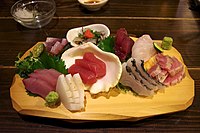
Photo from wikipedia
Abstract In this study the Integrated Multi-Trophic Aquaculture (IMTA) approach was examined at a gilthead seabream, Sparus aurata, farm located in the Eastern Mediterranean Sea. To achieve this, digestibility trials… Click to show full abstract
Abstract In this study the Integrated Multi-Trophic Aquaculture (IMTA) approach was examined at a gilthead seabream, Sparus aurata, farm located in the Eastern Mediterranean Sea. To achieve this, digestibility trials were conducted with three species representing different trophic levels, the grey mullet, Mugil cephalus, the sea urchin, Paracentrotus lividus, and the sea cucumber, Actinopyga bannwarthi using the particulate farm effluents as feed. To prepare the feeds, seabream faecal waste was collected by means of a large conical bag attached below a fish cage. The farm wastes were dried and pelleted after adding chromic oxide (indigestible marker) and alginate (binder). In the ensuing trials, the pellets were offered to the mullets, sea urchins and sea cucumbers. The faecal matter of the grey mullets was collected by stripping the fish, whereas for the sea urchins and sea cucumbers trials, faecal matter was collected by siphoning the faeces from the bottom of the tanks. The farm-waste feed and faeces of each of the tested species were analysed for chromic oxide, organic matter, protein, phosphorus, lipid, ash and energy content, and the apparent digestibility coefficient was calculated for each. The digestibility trial showed that mullets do not benefit nutritionally from the freshly deposited gilthead seabream wastes. However, both the sea urchins and sea cucumbers were able to obtain energy and nutrients from the gilthead seabream wastes, emphasising their potential as IMTA species. The sea cucumber expressed higher digestibility of the farm-waste feed than the sea urchin (11.7–45.9% and 3.8–16.3% respectively), which might be sufficient for productive growth based solely on a diet of “waste” material. These results demonstrate that IMTA systems based on detritivores in warm water locations allow to extract particulate wastes from commercial aquaculture farms and convert this to valuable biomass in the process.
Journal Title: Aquaculture
Year Published: 2019
Link to full text (if available)
Share on Social Media: Sign Up to like & get
recommendations!